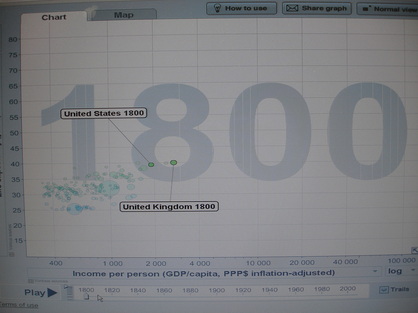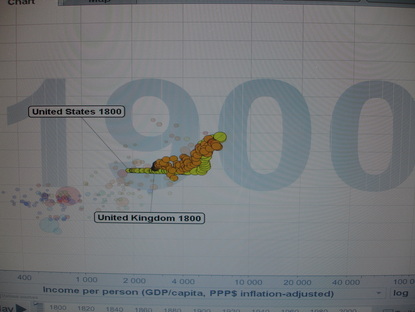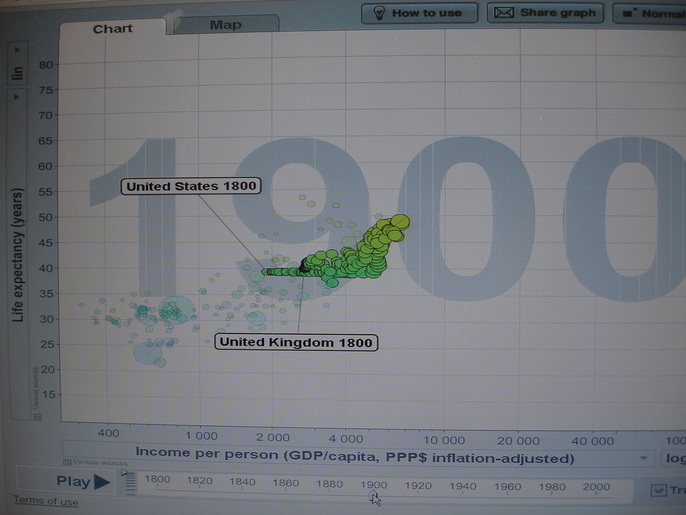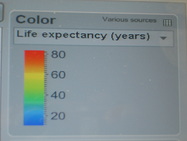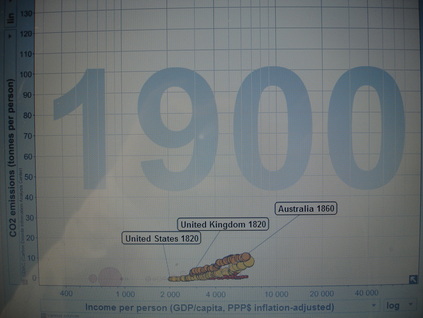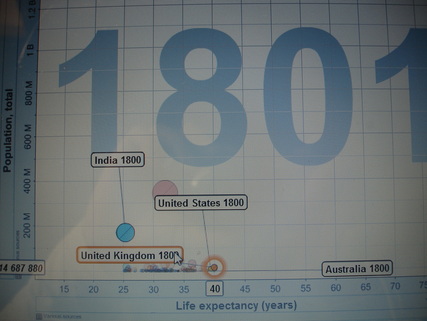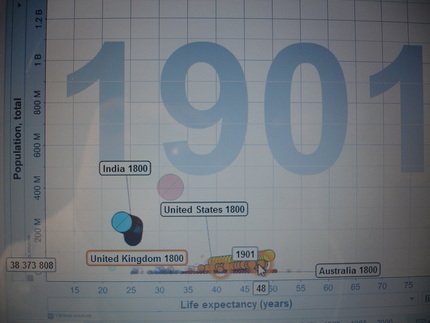19th Century Humanities
GAPMINDER
GRAPH 1: Life expectancy vs. Income per person
These graphs represent life expectancy in years and income per person for the countries in United Kingdom and United States. As compared in 1800 and 1900, life expectancy and income rose steadily. This can all conclude into one result, the technology and science had enhanced, making better lives for people. Just like evolution, people started to have longer lives.
GRAPH 2: CO2 emissions (tonnes per person) vs. Income per person (GDP/capita)
In the early 1820s, when urbanization had just started to mature in societies, CO2 emissions were still low due to it's "un-enhanced" science. Technology are not as advanced and steam engines were just starting to thrive. But as it gets towards the end of 1900, CO2 emissions increased because of the Industrial Revolution. People started creating more technology having to do with fuel. As you can see, Income per person also increased gradually since profits were able to be higher because of the new machineries invented to lessen the labor needed.
GRAPH 3: Population, total vs. Life expectancy (years)
In the early 1800s, United Kingdom had a life expectancy of 40 and a population total of 34 million. People were living short lives due to the fatal diseases discovered. The life expectancy had not been stable until the late 1800s, when science and technology improved, people started having more cures for the diseases. Life expectancy rose to age 48 and population increased to 38 million. Technology obviously had its side effects, but on the long run, it created longer lives and convenience for the rest of us.
Reflection
1) A) Which main topic does the artifact relate to? In what ways?
This relates to the evolution: science and religion topic because the increase of life expectancy and income of people depicts that science has been improving. The evolution of humans are now changing themselves into people who can live longer lives. Religion, on the other hand, is illustrated by the fact that income is becoming higher, it means that less and less people are more devoted in religions, more in modernization instead, because nuns and priests do not have high incomes nowadays.
B) Which other main topics does it also relate to?
This artifact also relates to economy because increasing income can also mean more improved economy therefore more profits.
2) Why did you choose this artifact, and how much time did you spend creating and/ or processing it?
I chose these two categories because it's the most common category throughout anything else but it needs an understanding while analyzing it. Gapminder is something that can also give you a visual presentation of the whole situation, definitely a good tool for interpreting data. I spent 1 hour processing this artifact.
3) What insights and understanding have you gained from the creation and/or processing of this artifact?
After this artifact, it is easier to realize what had happened to the people after major events. Some other countries, which were not shown on the graph, had major drops after the world wars. And this clearly shows who is on the top and who's on the bottom.
4) Does this artifact reflect your best work and/or ideas? Why, or why not?
This artifact doesn't really exactly reflect my best work because it has limited categories for the topics of the graph, therefore it may not be easy to express your idea.
5) Rate this artifact on a scale of -5 to 5 for the following 4 criterion:
A) impact on the quality of your portfolio 4
B) Impact on your level of happiness/enjoyment 3
C) impact on your learning 3
D) Level of creativity and originality 3
6) Any additional comments.
None.
This relates to the evolution: science and religion topic because the increase of life expectancy and income of people depicts that science has been improving. The evolution of humans are now changing themselves into people who can live longer lives. Religion, on the other hand, is illustrated by the fact that income is becoming higher, it means that less and less people are more devoted in religions, more in modernization instead, because nuns and priests do not have high incomes nowadays.
B) Which other main topics does it also relate to?
This artifact also relates to economy because increasing income can also mean more improved economy therefore more profits.
2) Why did you choose this artifact, and how much time did you spend creating and/ or processing it?
I chose these two categories because it's the most common category throughout anything else but it needs an understanding while analyzing it. Gapminder is something that can also give you a visual presentation of the whole situation, definitely a good tool for interpreting data. I spent 1 hour processing this artifact.
3) What insights and understanding have you gained from the creation and/or processing of this artifact?
After this artifact, it is easier to realize what had happened to the people after major events. Some other countries, which were not shown on the graph, had major drops after the world wars. And this clearly shows who is on the top and who's on the bottom.
4) Does this artifact reflect your best work and/or ideas? Why, or why not?
This artifact doesn't really exactly reflect my best work because it has limited categories for the topics of the graph, therefore it may not be easy to express your idea.
5) Rate this artifact on a scale of -5 to 5 for the following 4 criterion:
A) impact on the quality of your portfolio 4
B) Impact on your level of happiness/enjoyment 3
C) impact on your learning 3
D) Level of creativity and originality 3
6) Any additional comments.
None.
